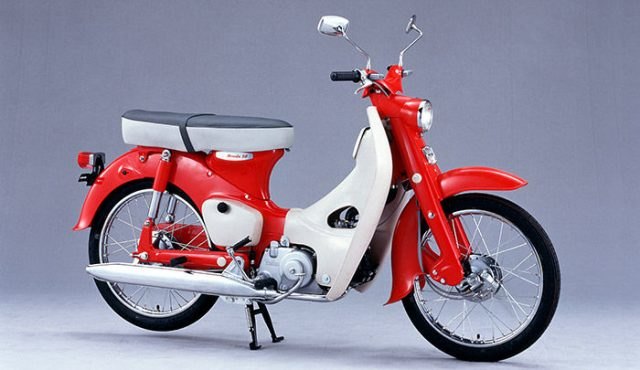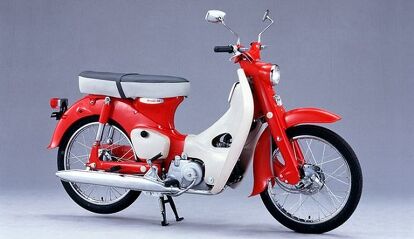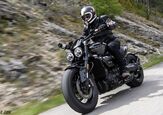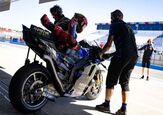100,000,000 Honda Super Cubs: How Many is That, and What Does It All Mean?
Frankly, I don’t know what it all means, but it seemed newsworthy when I posted the news this morning. One hundred million mass-produced anything seems like a lot. That’s not quite enough for every third American to own one now, but in 1958 when Honda started stamping Super Cubs out, it would’ve been enough for there to be one for every 1.8 Americans. Since the U.S. model included room for a passenger, that meant every man, woman and child could’ve been in transit simultaneously on a Super Cub, with room for a picnic basket.
Lately we seem to be missing out on the fun, since American Honda hasn’t imported a Super Cub since sometime in the `80s – which was called a Passport here to avoid potential legal havoc with Piper Aircraft. Millions of us tail-end Boomers caught a whiff of the Super Cub in the 50cc lay-down Single that also powered the Z50 minibike (there were 50, 70, 90 and 100cc Cubs).
How ironic, then, that it was that original C100 which led to the formation of The American Honda Motor Company in 1959 as official U.S. importer, inspired “You meet the Nicest People on a Honda” ad campaign, and basically made Honda the manufacturing juggernaut it is today. Maybe we “advanced” countries just outgrew the C100; Honda had bigger plans for us over the next few decades.
The story, according to Wikipedia and others, is that Soichiro Honda was in Europe on a single-minded mission to win the Isle of Man, but he was there with his more business-minded partner Takeo Fujisawa. They toured the Kreidler plant in Germany, the Lambretta scooter factory… none of these are any good for the common man, Fujisawa thought, who just wants cheap, easy, reliable transportation – on wheels big enough to deal with unpaved roads. Fujisawa reportedly told Honda, “If you can design a small motorcycle, say 50cc with a cover to hide the engine and hoses and wires inside, I can sell it. I don’t know how many soba noodle shops there are in Japan, but I bet you that every shop will want one for deliveries.”
From the start, Honda planned to harness great economy of scale to make the Super Cub a success. A new 10-billion yen factory in Suzuka was the biggest motorcycle plant in the world in 1960. Based on VW Beetle assembly-line principles, it was able to knock out 50,000 units per month with two shifts working. Triumph’s Edward Turner predicted trouble, since he said the U.S. market was already saturated. Later in 1965, when it turned out it wasn’t, he said Honda’s success would be great for the British bike industry, since it was bringing in new riders who’d graduate to bigger machines. He was right for a while, about another four years.
I’ve never been on a sex tour of Asia, but Editorial Director Sean assures me that as soon as one alights from the airplane in Vietnam, Thailand, India, China or any of those places I’ve managed to avoid, the Super Cub remains the vehicle of choice for 80% of the mobile population – and a further 18% of conveyances are propelled by engines that are knock-offs of the Cub’s indestructible air-cooled Single. The remaining 2% are in some sort of shiny, high-heeled slingback pump or platform wedgie…
Not that the Super Cub doesn’t have its share of fans outside of Asia. Starmag posted one installment of a series of videos made by an Englishman who’s attempting to make his life’s work avoiding a life of work, touring the world on a Super Cub instead. And he’s not the first.
What does it all mean? Beats me, but it’s nice to remember a time when we all aspired to “nice.” It’s reassuring to remember from what humble beginnings something like the most mass-produced vehicle of all time could sprout, given not much more nourishment than the tenacity of Soichiro Honda and his pal Mr. Fujisawa. It’s good to recount how repeatedly wrong the expert naysayers can be, it’s just plain fun how attached people can become to what’s really, let’s face it, a pretty mundane transportation unit. I kind of want one.
Here’s to 100,000,000 more. Set your timers, that should happen about 2037.
More by John Burns




































Comments
Join the conversation
Burns - the Motorhead in me wants to know how many Honda (and Honda copies) of that lay-down single have been made in 50cc, 70cc, and 90cc flavors - it might be 200 million as the Chinese have copied the crap out of it. All I can say is my Dad's 1971 Honda SL70 was waaaay better than my Briggs powered minibike - and I think it would maybe do 60mph downhill with one of my friends on the back... But I don't want a Super Cub - I want the latest and greatest lay-down single Chinese Pit Bike - I think they are up to 140cc or so now..
This was the first "motorcycle" I ever owned. Looked identical to the red one pictured. I won it on a Los Angeles radio contest, KRLA I think, when I was 15 in 1965. Rode that thing all over Southern California and had a blast!